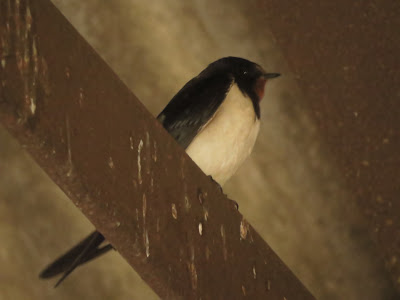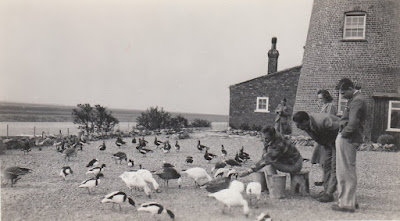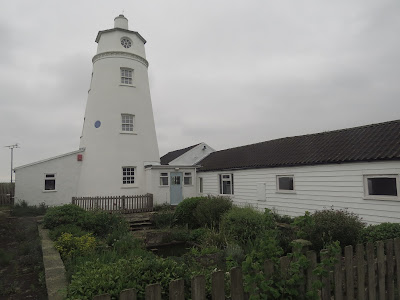29th
May to 2nd June fresh to gale N Mostly cloudy
with drizzle but also very intense thunder storm on the morning of
the 31st of May. And we call this Summer!
29th
May to Minsmere
So
after a rest at Dave's bungalow at Brandon and with antibiotics to
hopefully get rid of my sinus problem, I set off for Minsmere RSPB
reserve. A purple heron has been seen there and obviously that would
be a really good bird to get. I have never seen one whilst cycling so
it would be a '16' bird. That is one of the 16 I need over last
year's 289 in order to get beyond Ponc Feliu's European record of
304.
Cycling
towards Thetford the smallest of grass snakes is on the road in front
of me. I stop but this tiny ribbon of a snake has gone.
Now
in 29 months of Biking Birding ( 12 in 2010, 12 in 2015 and 5 this
year), I have only seen two dead snakes along the road. Now I see two
within the next ten miles, both adders. Shame. More 'car-nage'.
Late
afternoon, I arrive at the Island Mere hide. Bittern coming regularly
past to access it's nest beside the hide in the reeds. She comes out
and lands just yards in front and parades through short reeds.
Marsh
harriers and bearded tits, the savi's warbler reels once more over
the far side of the mere.
The
evening is cool with a northerly breeze. Darkness falls. Four young
people arrive, four members of the fabulous Next Generation Birders;
Jess, Jake, Drew and Dan. In the dark they have come to try to hear
the savi's at the end of a birding day that started at Spurn,
Humberside. How brilliant is it when one meets four driven birders of
such passion? Long may the NGBs have such people.
30th
May
Early
morning, and by that I mean 4:00am, I am up and hoping that a purple
heron will come out of the reeds. After an hour it hasn't when two
photographers arrive and tell me that it was seen in front of the
Bittern hide last night. I wait.
6:30am
– I move around to the Bittern hide.
7:10am
– the purple heron flies in front of the Island Mere hide.
7:30am
– I return to the Island Mere hide.
18:00
– Purple heron!
Those
intervening ten and a half hours I spent sitting in the same chair
mostly with a fourteen yr old birder-photographer, Harry. My reaction
to getting purple heron on the year list was euphoric. Well it would
be wouldn't it after waiting so long? I danced around the hide, I
fist thumped, I shouted!
Harry
had arrived at the hide with one of his Dad's friends, Dave. Both had
great photographic equipment and as Dave went off to explore the
reserve, Harry stayed behind to try to get a lifer for himself, the
purple heron.
The
hide was full for most of the day due to the presence of BBC's
Springwatch. It seemed funny when people's telescopes were trained on
the three presenters during their rehersals in the afternoon.
Bitterns,
marsh harriers and bearded tits gave views all day yet the best,
before the rare heron, occurred when an otter swam around in the
middle of the mere. It was fishing and caught a number of small fish
which were immediately eaten. This wonderful male thought it was a
dolphin and breeched a number of times as he dove deep. The sound of
gasps and delighted exclamations from the crowd was brilliant,
especially from a very excited small boy next to me with his sisters
and Mum and Dad. I love seeing children enjoying nature.
The
crowd thinned as the evening approached but I wasn't going to leave
my spot. I had been told where the purple heron had landed earlier in
the day, a spot way off to the west deep in the reedbed, and despite
the jokes that it could have walked to Ipswich by now, I waited.
Grey
herons kept coming out of the reeds, flying a short distance in the
northerly gale.
Then
a darker-looking heron came out.
I
shouted, “There it is!” I changed my mind, “no it isn't.”
Looked again all in a split second as my final cry confirmed to
everyone still present that the purple heron was indeed flying. “It
is the purple!”
With
everyone now on the bird, the special one flew around in the distance
before coming a lot closer and landing in the reeds opposite the
hide.
Up
again and off towards the bittern hide, Harry and I went there and
met a BBC producer who was coordinating a nest search for the
programme.
Harry's
Dad, Dave and the friend Dave arrived with sausage rolls and
doughnuts for all.
Purple
heron, bird number 249 and such a good one to get.
31st
May
The
day starts early once more with a loud thunderstorm accompanied by
intense rainfall. The water is coming in despite the hide shutters of
the East Hide being shut.
Two
birders come in to shelter at around six. Ian from Watford describes
how he has had six holes cut into his skull in order to remove a
brain abscess.
Simon
is the geography master at Harrow school who talks about his
experience of being in Sri Lanka on a school trip when the tsunami
hit their holiday resort.
Why
stay in a watch TV when one can be out meeting the real deal
fascinating characters?
A
couple of RSPB staff come in to bird and enthral the crowd of three.
A first summer little gull is out on the scrape and the adult
long-tailed drake. Now what on earth is he doing here and in six
inches of water?
I
spend the morning circumnavigating the scrape before heading off for
lunch.
4:30pm,
a text from the oracle – greenish warbler at Lowestoft.
7:30pm,
I am in the corner of a sports field with a few other more local
birders.
Dark
falls – no greenish. Oh well, there's always tomorrow.
1st
June
Greenish
warbler on the list . . . bird number 250!
2nd
June
I
am about to set off towards Lincolnshire when a text tells of a
Kentish plover fifty miles to the south in Felixstow.
Forty-five
miles later the news is negative, the bird has flown and hasn't been
seen for a couple of hours.






















































